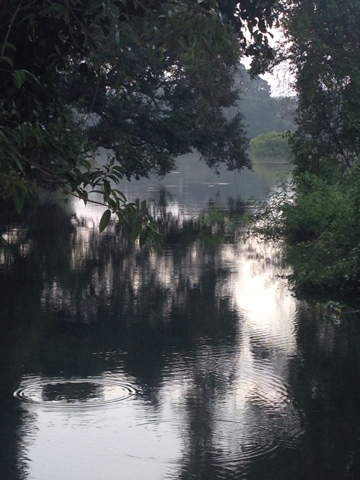This was my second time at Polonowurra. It was a little cooler so in that sense I guess I could tell you it was better. It is a marvelous place that brings up many more questions than it answers. Chief among these is how a whole people abandoned their former capital (Anuradhapura), moved to another part of the island, built from scratch extensive irrigation and agricultural systems, and constructed an enormous, powerful, and sumptuous capital in the middle of the jungle.
Polonowurra is spectacular but the facts on the ground are a bit different. Hawkers of postcards, Buddha statues, hats, plastic puzzles, and assorted carved objects are aggressively in your face. The place is full of tourists. There are no locals other than the hawkers. The sites are barely decipherable and there is so much to do there's little time to reflect. I would have been happy seeing the spectacular gal vihara (a series of Buddha statues and a reliquary chamber carved out of living stone) and one of my favorite places in Sri Lanka, the nelum pokuna, a gorgeously proportioned pleasure pool in the shape of a lotus.
Instead of complaining about Polonowurra, because really it is a must-see place, I want to share a few impressions of the tank at Giritale, which is where my guesthouse is located.
Giritale lies in a valley surrounded by mountains. Its tall, thick bund seems out of proportion with its size, which suggests to me the artificial lake is deep and subject to heavy inundation and strong currents. Remarkable scenery, like at every tank in this country large and small, abounds.
Also remarkable is the broad, deep layer of riprap on the far side of the bund, a structure that runs almost the length of the bund. I hadn't seen anything like it until yesterday, which reinforces the observation that every tank is unique. You would need several lifetimes to experience all 30,000 of these magnificent waterworks in every corner of Sri Lanka.
The complex ways that water is conducted in and around the bund is incredible. A double bisowateka at the bund surface gushes water gently like a spring. This is just the first part of a complex bisowateka that runs for hundreds of feet through a series of channels, traps, drops, turns, and assorted interventions The water collects in a small pool and then moves through several boxes before it disappears into the rip rap layer and emerges again through a pipe.
Here it meets another box, is forced to make a 90 degree turn, flows down a narrow canal more or less parallel to the bund, flows through several more boxes, and finally is directed away. Meanwhile it is met by a channel of water directed from the mountain our guesthouse is located on. The two streams meet an an acute angle which, like the rest of the system, has been carefully, even minutely engineered.
It's not just beautiful. The lines and channels and sluice boxes and grooves that comprise this wonder are the product of ancient engineers whose stonework has been replaced with concrete. But the shapes and slopes, the angles and the proportions here, are all original.
Giritale tank and its associated waterworks are alive. They are still in use as part of a water catchment and irrigation system that continues to be used, and which enriches the land for miles around.
As we pass the shimmering, almost iridescent rice fields every afternoon I try to see them as Julia and Jose must be experiencing them. A rare sight, ancient and endemic to Sri Lanka. Polonowurra is fascinating. But the countryside around it, fully engaged with human intercourse, is the more fascinating because it pulses with life.













No comments:
Post a Comment